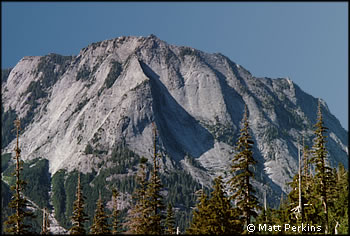|
I’d learned from Dan that the hand-drills made by Pika were
much superior to the little Rocpec things produced by Petzl. If you
just have to drill a few 1/4-inch emergency bolts somewhere, then the
Petzl is fine. The slightly greater mass of the Pika drill makes
hand-drilling 3/8-inch anchors a little more efficient. Since Pika
is no longer in business these drills are hard to find.. With a
decent stance one can get a 3-inch hole for a 3/8-inch bolt in six to
ten minutes. Typically we would lead with two drills: a 1/4-incher
with a Rocpec for quick temporary anchors and the Pika drill with
3/8-inch bits for more permanent ones. We used 3/8-inch x 3-inch
stainless steel wedge anchors on most of the placements and every
belay has some kind of descending rig.
After a masochistic thrash through steep trees next to the
route, one can emerge onto the ledges that mark the top of the
fifth pitch. At this point, we got our first real glimpse of the
project’s true nature. Some hair-ball scrambling way out
left and back again can yield a couple hundred more feet. The
highest tat we found on the route corresponded to the highest
place reachable by scrambling back and forth on sloping ledge
systems.
The bottom seven pitches were done from the top down, as most
modern Darrington routes have been. First two guys toprope
various possibilities, carefully mark the protection locations
with dabs of chalk and argue about the results for an
indeterminate period of time. Once consensus is reached, in a
fairly simple and anticlimactic effort, two or three guys place a
half dozen anchors and then go for the lead.
In the spring of 2006, Dan and I discovered the Cookie Sheet
down in the Merced Canyon and began to develop the Tuolumne-style
climbs we found there. Down there, ya gotta do ’em on the
lead to be taken seriously — so with that sort of
requirement I’d gone full circle. I was back hand-drilling
on the sharp end again, just like the seventies, only with a
bigger hammer, a carbide drill-tip and fat herkin’
stainless steel bolts.
The moment was a granite epiphany of sorts and we came home from
the valley after honing up the only skills that were gonna see us
through. I dusted off some 30-year-old bat hooks and a few thin pins
and that old retro-seventies feeling was back again!
We’d set out on a new pitch with two sizes of
hand-drills, five or six bolt and hanger assemblies, a pocket
full of 1/4-inch button-head bolts, 2 or three pitons, 4-5
small cams and some wireds, a big hammer, extra bits, assorted
allen wrenches for the drill tool, and a larger wrench for the
bolts. Various hooks and bathooks and maybe a set of ultra-light
aiders made from cleverly-tied half-inch material. Added to that
were helmet, chalkbag, sunglasses, a short piece of straw from
yesterdays Starbuck’s to blow dust outta the hole and
you’re ready to start your pitch.
In the end we had to go up for three days to get anywhere.
We’d climb to the Balcony the first day and maybe fix another
pitch if strength allowed. Then the second day we’d fix all
our old ropes up to the seventeenth or eighteenth pitches and leave
some hardware hanging there. Finally, if we were lucky and it
didn’t rain, we’d start the third morning with our packs
full of iron and jumars in our faces. An hour or so later we’d
be at the frontlines, nervously racking up, nervously watching the
sky, the wind, and the time. Then late in September of 2008, late in
the day, and late in my climbing career, Bill shouted off belay from
the umbrella tree and 40-feet later we were standing in summit
heather.
|



